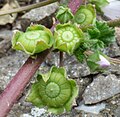Malva neglecta
| Malva neglecta | |
|---|---|

| |
| Scientific classification | |
| Kingdom: | Plantae |
| Clade: | Tracheophytes |
| Clade: | Angiosperms |
| Clade: | Eudicots |
| Clade: | Rosids |
| Order: | Malvales |
| Family: | Malvaceae |
| Genus: | Malva |
| Species: | M. neglecta
|
| Binomial name | |
| Malva neglecta | |
Malva neglecta is a species of plant of the family Malvaceae, native to most of the Old World except sub-Saharan Africa. It is an annual growing to 0.6 m (2 ft). It is known as common mallow in the United States and also as buttonweed, cheeseplant, cheeseweed, dwarf mallow, and roundleaf mallow.[2] This plant is often consumed as a food, with its leaves, stalks and seed all being considered edible.[3][4][5] This is especially true of the seeds, which contain 21% protein and 15.2% fat.[6]
Description[edit]
Dwarf mallow is a prostrate, downy, annual herbaceous plant, growing to approximately 60 cm. The leaves are alternate with long, strongly channeled petioles (up to 12 cm) and narrowly triangular stipules. Each leaf is reniform or with 5–7 shallow lobes, the basal leaves are 3–7 cm. The flowers are single-stalked and occur in clusters of 2–5 in the leaf axils. The flower stalks are shorter than the leaf stalks, with the leaves partially obscuring the flowers. The fruits are schizocarps, which split into 10–12 mericarps (nutlets) and are smooth and hairy.[7][8]
Distribution[edit]
- Native
- Palearctic:
- Macaronesia: Canary Islands
- Northern Africa: Algeria, Morocco
- Arabian Peninsula: Saudi Arabia
- Western Asia: Afghanistan, Cyprus, Sinai, Iran, Iraq, Israel, Jordan, Lebanon, Palestinian Territories, Syria, Turkey
- Caucasus: Armenia, Azerbaijan, Georgia
- Soviet Middle Asia: Kazakhstan, Kyrgyzstan, Tajikistan, Turkmenistan, Uzbekistan
- Mongolia: Mongolia
- China: Xinjiang
- Indian Subcontinent: India, Pakistan
- Northern Europe: Denmark, Ireland, Norway, Sweden, United Kingdom
- Middle Europe: Austria, Belgium, Czech Republic, Germany, Hungary, Netherlands, Poland, Slovakia, Switzerland
- Southeastern Europe: Albania, Bosnia and Herzegovina, Bulgaria, Croatia, Greece, Italy, Montenegro, North Macedonia, Sardinia, Serbia, Slovenia, Romania,
- Southwestern Europe: France, Portugal, Spain
Source:[1]
Uses[edit]
Leaves and young seeds can be eaten raw or cooked. Mature seeds should be cooked like rice or grains.[9]
Botanical gallery[edit]
-
Plant spreads along ground, leaves not large, leaves fairly uniform size (Antalya)
-
Spreading on rocks, similarly (Edinburgh)
-
Flowers, fruits and leaves
-
Flowers, fruits and leaves, closer
-
Flowers pinky with bold veins or may be pale
-
Paler form, hairs (visible) in centre at petal stalks
-
Flower much larger than calyx, green calyx with 5 broad parts, epicalyx at base formed of 3 narrow strips
-
Flowers may have long to very long stalks
-
Fruits
-
Fruits
-
Fruiting undersides, showing epicalyx of 3 narrow strips
-
Flowers and fruits from side showing the features above, stalks reasonably long
-
Hairs a mixture of stellate (star-like) and simple
-
Hairs a mixture of stellate (star-like) and simple
-
Leaf
-
Leaf underside
-
Leaf underside
References[edit]
- ^ a b "Malva neglecta". Germplasm Resources Information Network. Agricultural Research Service, United States Department of Agriculture. Retrieved 20 April 2017.
- ^ "Malva neglecta". Integrated Taxonomic Information System. Retrieved 9 May 2008.
- ^ Facciola S. Cornucopia – A Source Book of Edible Plants. Vista, Ca. Kampong Publications, 1990. 677 p.
- ^ Archived at Ghostarchive and the Wayback Machine: Wild Living with Sunny: Episode 16 - Mallow Plant S'mores. YouTube.
- ^ "Malva neglecta Dwarf Mallow, Common mallow PFAF Plant Database".
- ^ Duke JA. CRC Handbook of Proximate Analysis Tables of Higher Plants. Boca Raton, Fl. CRC Press, 1986. 389 p.
- ^ Stace, C.A. (2019). New Flora of the British Isles. Suffolk. ISBN 978-1-5272-2630-2.
{{cite book}}: CS1 maint: location missing publisher (link) - ^ Rose, Francis (2006). The Wild Flower Key. London: Frederick Warne. ISBN 978-0-7232-5175-0.
- ^ Nyerges, Christopher (2017). Foraging Washington: Finding, Identifying, and Preparing Edible Wild Foods. Guilford, CT: Falcon Guides. ISBN 978-1-4930-2534-3. OCLC 965922681.
External links[edit]
 Media related to Malva neglecta at Wikimedia Commons
Media related to Malva neglecta at Wikimedia Commons Data related to Malva neglecta at Wikispecies
Data related to Malva neglecta at Wikispecies- UniProt. "Species Malva neglecta (Common mallow)". Retrieved 9 May 2008.
- Natural Resources Conservation Service (NRCS). "PLANTS Profile, Malva neglecta". The PLANTS Database. United States Department of Agriculture. Retrieved 9 May 2008.
- "Malva neglecta". Plants for a Future.
- "Malva neglecta". Calflora. Berkeley, California: The Calflora Database.
- Malva neglecta in the CalPhotos photo database, University of California, Berkeley

















